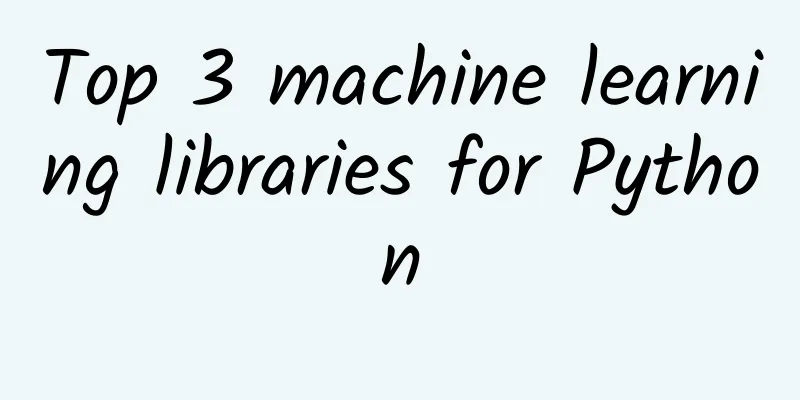Top 3 machine learning libraries for Python

|
【51CTO.com Quick Translation】It turns out that we can navigate the world of machine learning without mastering the difficult data science. Of course, this journey inevitably requires the help of various big data, artificial intelligence, deep learning, and large-scale statistical and analytical tools.
In today’s article, we will take a look at three of the most popular Python machine learning libraries, which we believe will help you have a smoother data science exploration experience. 1. Theano Theano, a machine learning solution that was born about ten years ago, is currently one of the most widely used CPU and GPU mathematical compilers in the field of machine learning. In the paper "Theano: A Python Framework for Fast Mathematical Expression Computation", the authors give a comprehensive overview of the library. "Theano includes multiple packages to enhance its functionality. It provides a high-level user interface that is sufficient to handle a variety of specific goals," the paper explains: "Lasagne and Keras can effectively simplify the architectural expression of deep learning models and training algorithms as mathematical expressions. In fact, the probabilistic programming framework PyMC3 uses Theano to automatically generate expressions and quickly execute the generated C code. (Keras and Lasagne run on both TensorFLow and Theano.)" Theano currently has over 25,000 commits and nearly 300 contributors on GitHub, and the number of forks is approaching 2,000. 2. TensorFlow TensorFlow is an open source library for numerical computation using data flow graphs. Although it is a newcomer in the open source field, this project led by Google already has nearly 15,000 submissions and more than 600 GitHub contributors, and the model library has a star rating of nearly 12,000. In the first Open Source Yearbook, TensorFlow was selected as the most worthy fork project in 2016. In the latest Open Source Yearbook, TensorFlow also appeared many times. The Magenta project based on TensorFlow is even trying to connect machine intelligence with the art field, exploring how to use it to achieve music and art creation, and thus establish a mixed community of artists, programmers and machine learning researchers. In addition, Tensorflow supports multiple front-end languages, but its support for Python is the best, and Python is also listed in the 2017 hot programming trend rankings. TensorFlow 1.0 was launched in mid-February this year. Google wrote in its developer blog: "Although it is only a year old, TensorFlow has helped researchers, engineers, artists, students and other users to complete various tasks, ranging from language translation, early diagnosis of skin cancer to prevention of concurrent blindness in diabetic patients." 3. scikit-learn This solution is based on NumPy, SciPy and Matplotlib, and is used by engineers at Spotfiy for music recommendations. At OkCupid, it is responsible for evaluating and improving the matching system. At Birchbox, staff are exploring how to use scikit-learn to support the development of new products. Scikit-learn currently has nearly 22,000 commits and 800 contributors on GitHub. [Translated by 51CTO. Please indicate the original translator and source as 51CTO.com when reprinting on partner sites] |
<<: Aiti Tribe Stories (10): Voices from Technical Promotion Managers
>>: How to build an Android MVVM application
Recommend
How to make a blessing video from Africans?
Non-standard Chinese pronunciation, (WeChat: jimi...
History of human war against epidemics丨He built more than 500 microscopes out of interest, and the "small animals" he recorded shocked the world
Malaria, smallpox, influenza...Epidemics have acc...
The magical "Sarebo" and the noble "Jiusi Zheer"
In the middle of Lushan Scenic Area in Xichang, t...
Analysis of 2019 Overseas Social Media KOL Marketing Trend Report
Overseas social media KOL marketing has attracted...
[Creative Cultivation Program] Gunfire, Bullets and Armor: The MAX Version of the Mantis Shrimp
At 11 a.m. on July 8, 2022, at the Shirahama Aqua...
Do you need to disinfect your home every day? Master these 9 points to achieve scientific disinfection!
Source: CCTV News...
In 2015, Internet Marketing Will Never Be Moral
Is China's Internet in a prosperous or chaoti...
Galaxy Z Flip's "glass screen" doesn't seem as durable as Samsung claims
Samsung launched its second foldable phone, the G...
Understand the latest developments in AI in one article! A guide for workers →
In March 2023, AI technology represented by GPT-4...
New media content planning process and writing steps!
Someone asked me what is the content production p...
The Forbidden City lipstick became popular overnight: the important forces of advertising, public relations and KOL!
The Palace Museum has successfully achieved the r...
Is it really enough for Tencent to position itself as an assistant in the smart car industry?
At the Tencent 2018 Global Partner Conference hel...
Brand marketing innovation theory!
In the previous article "Brand Innovation Th...
ASO Optimization: Detailed Explanation of App Store Ranking Rules
ASO optimization obviously affects the first step...
The beautiful temptation hidden in your home, don't bring it into your bedroom...
A few gorgeous flowers are dotted in her fluffy h...









